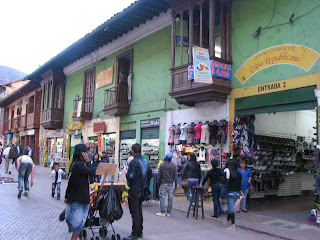 |
| Grillwork over a restaurant doorway on Calle 10 in La Candelaria. |
"This city stands out for the abandonment of the neighborhood,"
Bourlon told El Tiempo. "The neighborhood's architecture is exception, but curiously it's not valued."
Bourlon's only half right. Bogotá's historical center does have lots of architectural jewels, many of them neglected. But, Bourlon might keep in mind that Paris is the capital of a rich nation and a tourist mecca, while Bogotá is the capital of a poor nation still embroiled in an armed conflict which only recently has achieved enough stability to attract tourists and to think about things like renovating old buildings.
 |
| On Carrera 2, in the heart of La Candelaria, this apartment complex is said to have been the first in Bogotá. For many years, it was occupied by squatters. Police moved them out, and the building is now vacant, for sale and slowly decaying. |
If Bourlon had looked closely, he'd have noticed that lots of historic buildings here have been renovated - but that many others have been neglected - and might just collapse unless they get help soon.
 |
| The owner of the Hotel Abadia Colonial on 10th St. did a wonderful renovation job. |
 |
| The building beside it was also recently renovated - altho the woodwork is a bit suggestive of a ski chalet. |
 |
| Why don't they scrub the ugly graffiti off of Simon Bolívar's statue in Plaza Bolívar? |
 |
| And off of this wall on Carrera 3? But it'd just get painted again. The best option might be to get some really talented muralists to decorate it. |
 |
| Calle 10, one of the neighborhood's best preserved streets. All of the old buildings, many of them dating from colonial times, are still used: there's a bakery, hostel, dance studios, neighborhood groceries and residences. |
 |
| This family on Carrera 2 has kept their home - and its balcony - in great shape. |
 |
| This iron letter slot on La Forja's door certainly appears historic - even tho it's probably new. |
Bogotá has strict rules on modifications of the city's historic buildings. In some cases, however, owners have found it easier and cheaper to just let an old building collapse and then build another one, rather than renovate the historic structure.
 |
| Sagging houses on 12th St. |
 |
| This faux-historic burger joint on Calle 11 and Carrera 2 was built after the previous building was allowed to collapse. |
 |
| A nice-looking building on 14th Street. The textures of the roofs give La Candelaria a warm feeling. |
 |
| The Casa del Sol on Carrera 3 now contains luxury apartments, but has a grim history. Originally a monastery, it was used as the secret police headquarters during Colombia's last dictatorship, in the 1950s. |
 |
| The opera house on 10th St. is being renovated - another seemingly endless public work. But someday they'll finish. |
 |
| The elegant Hotel de La Opera. |
 |
| A church right off of the Plaza Bolívar, under renovation. La Candelaria is full of colonial churches. |
 |
| The courtyard of the one-time home of the virrey - Spanish king's man in Colombia. Today, it's a public theatre and art gallery, on Calle 10 and Carrera 3. |
 |
| The neighborhood's many private universities have renovated many older buildings. |
Urban planner Bourlon also suggested making more of La Candelaria into a pedestrian district - a great idea, which would eliminate some of the stress and pollution from the car traffic. They've turned the lower part of 11th into a pedestrian street, and hopefully will continue up the street.
 |
| 11th St., made pedestrian-only, alongside City Hall. |
 |
| City Hall is also being renovated and expanded. With Mayor Samuel Moreno suspended from office over a corruption scandal, does Bogotá really need more bureaucrats? |












































No comments:
Post a Comment